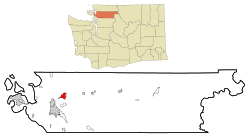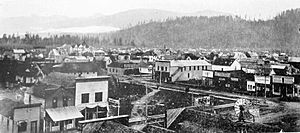Sedro-Woolley, Washington facts for kids
Quick facts for kids
Sedro-Woolley, Washington
|
|
|---|---|

Sedro-Woolley welcome sign, pictured in 2005
|
|
| Nickname(s):
Woolley
|
|

Location of Sedro-Woolley in Washington state
|
|
| Country | United States |
| State | Washington |
| County | Skagit |
| Incorporated | December 19, 1898 |
| Government | |
| • Type | Mayor–council |
| Area | |
| • Total | 4.31 sq mi (11.16 km2) |
| • Land | 4.31 sq mi (11.16 km2) |
| • Water | 0.00 sq mi (0.00 km2) 0% |
| Elevation | 56 ft (17 m) |
| Population
(2010)
|
|
| • Total | 10,540 |
| • Estimate
(2019)
|
12,072 |
| • Density | 2,801.58/sq mi (1,081.75/km2) |
| Time zone | UTC-8 (PST) |
| • Summer (DST) | UTC-7 (PDT) |
| ZIP code |
98284
|
| Area code | 360 |
| FIPS code | 53-63210 |
| GNIS feature ID | 1512653 |
Sedro-Woolley (pronounced SEE-droh WOO-lee) is a city located in Skagit County, Washington, United States. It's part of a larger area that includes nearby cities like Mount Vernon and Anacortes. In 2020, about 12,421 people lived here.
Sedro-Woolley is special because it's home to the main offices for North Cascades National Park. This amazing park is just east of the city, along State Route 20.
Contents
History of Sedro-Woolley
Sedro-Woolley became an official city on December 19, 1898. It was created by joining two smaller, competing towns: Sedro and Woolley. These towns were in northwestern Washington, about 25 miles (40 km) from the Puget Sound. They were also about 40 miles (65 km) south of the Canadian border and 65 miles (105 km) north of Seattle.
How Sedro Got Its Name
In 1878, four British friends, led by David Batey, settled in this area. Later, in 1884–85, a man named Mortimer Cook and his family moved here. Cook had been a mayor in California. He wanted to name his new town "Bug" because there were so many mosquitos! Luckily, his wife and other local women didn't like that name.
So, Cook came up with a new idea. He knew the Spanish word for cedar tree was "cedro." He changed one letter to make the name unique, and that's how "Sedro" was born.
The Rise of Woolley
The original town of Sedro was built near the Skagit River, which meant it often flooded. In 1889, a railroad developer named Nelson Bennett started building train tracks towards Sedro. Another developer, Norman R. Kelley, planned a new Sedro town on higher ground, about a mile away.
Soon, more railroads came through the area. A railroad developer named Philip A. Woolley moved his family to Sedro in 1899. He bought land where the railroads crossed and built a lumber and shingle mill. He started his own company town there, which he named "Woolley." This town grew by selling railroad ties to the train companies.
Eventually, on December 19, 1898, the towns of Sedro and Woolley officially merged to form the city we know today: Sedro-Woolley.
The Great Elephant Adventure
On May 15, 1922, something wild happened in Sedro-Woolley! A circus elephant named Tusko escaped from the Al G. Barnes Circus. Tusko was the biggest circus elephant at the time, standing over 10 feet (3 meters) tall and weighing about 7.5 tons (6,800 kg).
Tusko caused quite a stir! He knocked down fences, telephone poles, and even destroyed a Model T car. Local residents chased him for 30 miles (48 km) through the countryside. Luckily, he was captured the next morning without anyone getting hurt.
From Logging to New Industries
For a long time, logging and coal mining were the main jobs in Sedro-Woolley. But as these industries slowed down, new businesses emerged. One important company was Skagit Steel & Iron Works. It started small but grew to supply parts for logging and railroads. During World War II, they even made machines for the war effort.
By 1990, Skagit Steel & Iron Works closed, and a large mental health facility called Northern State Hospital also shut down. But Sedro-Woolley is always growing! Today, new industries like robotics and aerospace are developing north of town and on the old hospital grounds.
Education in Sedro-Woolley
The Sedro-Woolley School District manages the public schools in the city. It also serves nearby communities like Big Lake and Clear Lake.
The district has:
- One high school (Sedro-Woolley High School)
- One middle school
- Seven elementary schools
- Several special programs, including a Job Corps center that helps young people learn job skills.
Culture and Fun Events
Sedro-Woolley is famous for its annual event called Loggerodeo. This celebration has been happening every year since the mid-1930s, usually around the Fourth of July. It's one of the oldest summer celebrations in Washington state!
Loggerodeo is packed with exciting activities:
- A fun carnival
- A foot-race
- A log drive (like the old days when logs floated down rivers)
- An old-time logging show
- A championship rodeo
- A children's parade and the main Fourth of July parade
- An invitation-only chainsaw carving competition, where artists create amazing sculptures from logs.
You can see many of these cool chainsaw carvings displayed around downtown Sedro-Woolley from past competitions. The city is also home to Hal's Drive-In, a beloved local restaurant that has been a favorite for decades.
Geography and Climate
Sedro-Woolley covers an area of about 3.81 square miles (11.16 square kilometers), and all of it is land.
The city has a warm-summer Mediterranean climate. This means it has warm, dry summers and mild, wet winters. It's a bit like the climate you'd find in parts of California or around the Mediterranean Sea.
| Climate data for Sedro-Woolley | |||||||||||||
|---|---|---|---|---|---|---|---|---|---|---|---|---|---|
| Month | Jan | Feb | Mar | Apr | May | Jun | Jul | Aug | Sep | Oct | Nov | Dec | Year |
| Record high °F (°C) | 67 (19) |
74 (23) |
82 (28) |
94 (34) |
95 (35) |
99 (37) |
98 (37) |
97 (36) |
91 (33) |
86 (30) |
76 (24) |
74 (23) |
99 (37) |
| Mean daily maximum °F (°C) | 44.4 (6.9) |
48.7 (9.3) |
53.3 (11.8) |
59.6 (15.3) |
65.6 (18.7) |
70.1 (21.2) |
74.9 (23.8) |
74.9 (23.8) |
69.2 (20.7) |
60.5 (15.8) |
50.8 (10.4) |
45.6 (7.6) |
59.8 (15.4) |
| Mean daily minimum °F (°C) | 32.4 (0.2) |
33.9 (1.1) |
36.3 (2.4) |
39.9 (4.4) |
44.3 (6.8) |
48.7 (9.3) |
50.4 (10.2) |
50.5 (10.3) |
47.2 (8.4) |
42.4 (5.8) |
37.4 (3.0) |
33.9 (1.1) |
41.5 (5.3) |
| Record low °F (°C) | −2 (−19) |
−1 (−18) |
8 (−13) |
25 (−4) |
25 (−4) |
30 (−1) |
31 (−1) |
34 (1) |
28 (−2) |
20 (−7) |
3 (−16) |
1 (−17) |
−2 (−19) |
| Average precipitation inches (mm) | 5.75 (146) |
4.21 (107) |
4.32 (110) |
3.56 (90) |
2.86 (73) |
2.56 (65) |
1.45 (37) |
1.71 (43) |
3.05 (77) |
4.61 (117) |
6.48 (165) |
6.05 (154) |
46.6 (1,180) |
| Average snowfall inches (cm) | 3.3 (8.4) |
1.3 (3.3) |
1.4 (3.6) |
0 (0) |
0 (0) |
0 (0) |
0 (0) |
0 (0) |
0 (0) |
0 (0) |
0.7 (1.8) |
2.2 (5.6) |
8.9 (23) |
| Average precipitation days | 19 | 16 | 18 | 15 | 13 | 11 | 6 | 7 | 11 | 15 | 20 | 20 | 171 |
Population and People
| Historical population | |||
|---|---|---|---|
| Census | Pop. | %± | |
| 1900 | 885 | — | |
| 1910 | 2,129 | 140.6% | |
| 1920 | 2,379 | 11.7% | |
| 1930 | 2,719 | 14.3% | |
| 1940 | 2,954 | 8.6% | |
| 1950 | 3,299 | 11.7% | |
| 1960 | 3,705 | 12.3% | |
| 1970 | 4,598 | 24.1% | |
| 1980 | 6,110 | 32.9% | |
| 1990 | 6,031 | −1.3% | |
| 2000 | 8,658 | 43.6% | |
| 2010 | 10,540 | 21.7% | |
| 2020 | 12,421 | 17.8% | |
| 2021 (est.) | 12,509 | 18.7% | |
According to the 2010 census, there were 10,540 people living in Sedro-Woolley. The city had 3,995 households and 2,609 families.
Most of the people living in Sedro-Woolley were White (86.1%). About 14.0% of the population identified as Hispanic or Latino.
The average age of people in the city was 33.7 years old.
- About 27.3% of residents were under 18.
- 28.2% were between 25 and 44 years old.
- 12.7% were 65 years or older.
There were slightly more females (51.7%) than males (48.3%) in the city.
Images for kids
See also
 In Spanish: Sedro-Woolley (Washington) para niños
In Spanish: Sedro-Woolley (Washington) para niños



